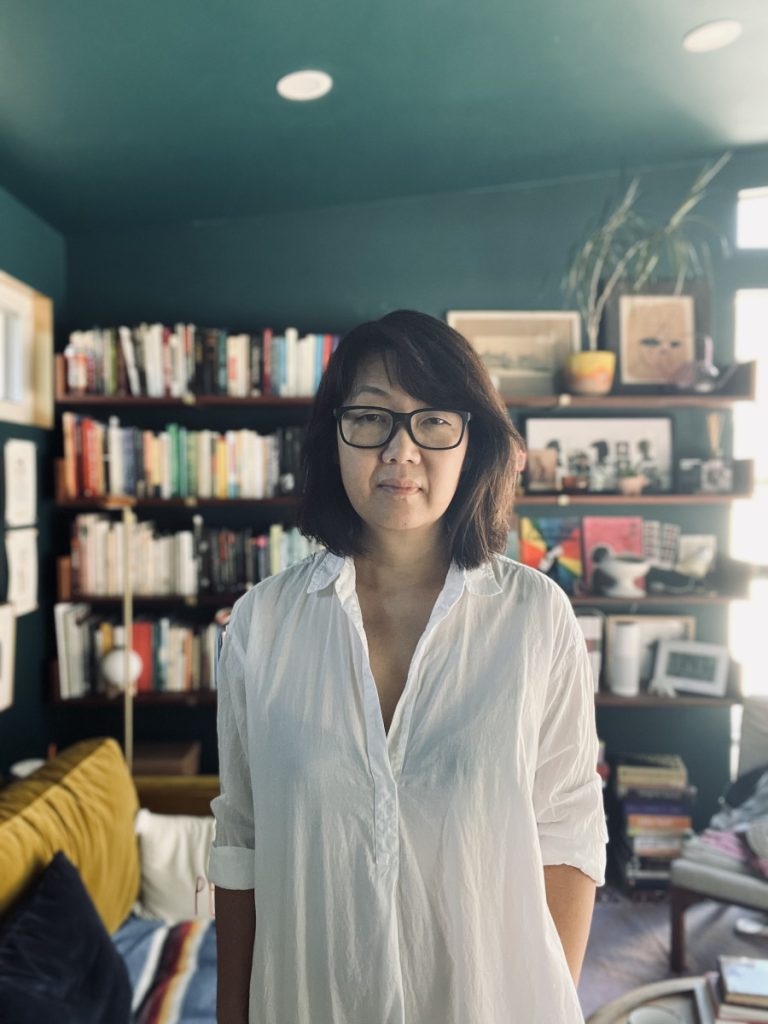
Fiction reader Katy Cesarotti talks with Caroline Kim about cultural identity, dichotomy, and the unsaid in her story “Hiding Spot” (NER 43.3).
Katy Cesarotti: The story opens as Mrs. Lee’s son, Ken, visits home with his girlfriend after two years of estrangement. The first section closely follows Mrs. Lee; later the story hinges to her son, Ken, and we see his childhood home through his eyes. Can you talk about your use of perspective in this piece?
Caroline Kim: I used to think I had to write from only one perspective—first, second, or third—and if close third, stay with a specific character. But the longer I write, the less rigidly I feel about such things. When I began this story I thought it “belonged” to Mrs. Lee because it largely unfolds from her perspective. It wasn’t until I finished the first draft and was reading it back that I even noticed that there were times when the story moved into Ken’s point of view. I hadn’t noticed it at all while I was writing. But it kind of felt like the story was telling me something by the ease with which it moved back and forth between them: that the story didn’t belong to one character or the other but was about their need and desire to connect with each other.
KC: The title, “Hiding Spot,” refers explicitly to Mrs. Lee’s hidden rings. One of the things I loved most about this piece is the balance between concealing and revealing, what’s said and unsaid. How did you think about hiding in this story? What inspired you to explore this theme?
CK: Mrs. Lee has a long relationship with hiding things. Some are tangible and valuable, like jewelry or cash, and some are reminders of the past, like old photographs and letters from Korea. Even more importantly, she’s been able to keep a part of herself hidden from others. An essential piece of herself outside of whatever was expected of her as a woman or a mother or an immigrant.
Even though the theme of hiding seems so glaringly obvious to me now—it’s even in the title!—I wasn’t aware of it for a long time. Because the story begins with a moment of crisis in Mrs. Lee’s life, when she can’t find the jewelry she thought she had so cleverly hid, it seemed natural to write toward other times and other parts of her life when she felt the urge to hide. Ironically or not, these moments were the ones that revealed Mrs. Lee most clearly to me.
KC: Mr. Lee is a quiet presence in the story, but he fills the space: the bookshelves of his Korean war books, his silences. Can you describe how you approached the two partnerships of the story: Mr. Lee and Mrs. Lee, and Ken and Celeste?
CK: Even though Mr. Lee is not the greatest parent or husband, I have a lot of sympathy for him. Mr. Lee is a person who’s given up due to his difficult life, much of it coming from his experiences as an immigrant. I describe him in the story as “whittled . . . down to someone who only wanted life to be agreeable.” This has led him to become a shell of the person he once was—a person who reacted too often with anger and violence but who also knew how to have fun, enjoy music, was open to life. But now routine is what’s keeping him alive. Because of all this, he’s more tragic to me than Ken or his mother who at least want to keep trying to connect with each other.
In terms of the two partnerships in the story: Mr. and Mrs. Lee and Ken and Celeste, they don’t have much in common. Mr. and Mrs. Lee’s relationship comes from a different time, a different culture. It’s frozen in time. On the other hand, there’s a lot of uncertainty yet in Ken’s and Celeste’s relationship, there’s also hope.
KC: Despite her vivid presence on the page, Mrs. Lee goes without a first name throughout the story. So does Mr. Lee. Ken’s girlfriend is often referred to as “the girl” until he finally reveals that her name is Celeste. Can you talk about naming and identity in this piece in relation to their familial roles?
CK: Great question. As a Korean American writer, I often find myself struggling with names for a variety of reasons. In the first place, Korean and American cultures have different attitudes toward them. In America the individual’s name is extremely important to identity—I think of this whenever I see monogrammed towels—whereas in Korea, one’s relationship to others is what’s paramount. Even now I couldn’t tell you the first names of my relatives—I only know them as “Younger-Aunt-on-Father’s-Side” or “Oldest-Uncle-on-Mother’s Side”. Neither way is better nor worse; they just tell us different things about their cultures.
I also feel conflicted because I’m aware that the minute I give my character a name like “Dongwon” some sense of distance is created. And I can understand why—the name feels unfamiliar because it is unfamiliar. Foreign, on the page as well as the eye, ear, tongue, and mind. As a reader in English only, it looks unfamiliar to me too. At the same time, how else can we make the unfamiliar familiar except by normalizing the fact that in America many of us have foreign-sounding names?
Each story is different and calls for its own negotiations with names, but usually I don’t name my characters until it becomes necessary in the story. In this case, Mrs. Lee’s first name is never revealed because it never comes up—sadly, there’s no one in her life close enough to her to use her personal name.
The reason Mrs. Lee refers to Celeste as “the girl” for most of the story reflects her general feeling of disconnection from American culture. Looking at Celeste, she feels she has no entry into understanding what a young white American girl like her thinks, feels, or cares about and vice versa, that she is unfathomable to Celeste. Even so, she knows she has to try and finally says Celeste’s name out loud for the first time at the end of the story.
KC: By the end of the piece, Ken and Mrs. Lee reach a fragile détente. How do you see the characters’ development over the story—how has their relationship changed, or failed to change?
CK: I feel quite a lot of hope for Ken and Mrs. Lee going forward. It’s not going to be easy or perfect, but they finally establish a connection with each other in the car. Though she’s still enormously worried about him, especially with all the responsibilities of fatherhood headed his way, she recognizes that he’s made real changes in his life. Wanting to show him her support, she gives him her mother’s jade ring and tells him to give it to the person he chooses.
KC: What’s on your to-read list right now?
CK: Recently I went down a Jean Rhys rabbit hole and read all of her novels. I’m now reading a biography of her life. I was powerfully struck by the immediacy of her writing, how fresh and alive it still feels. Her books feel like they could be published today.
Otherwise, I’m mostly doing research reading for my novel which is set in the 1890s, when the Yi Dynasty in Korea effectually ended with the murder of Queen Min by Japanese assassins. So, lots of very interesting history books about that time of the world, when the industrial revolution began changing the East as much as the West, when monarchies began crumbling everywhere or were violently overthrown, and it became no longer possible for Korea to hide as the Hermit Kingdom anymore. Ha! And there we are back to hiding.

Katy Cesarotti is a fiction reader for the New England Review. Her work has appeared in Story and the Southwest Review. She lives in Chicago with a pile of books and some very thirsty plants.